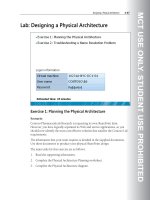Designing a Microsoft SharePoint 2010 Infrastructure Vol 2 part 26 pptx
Bạn đang xem bản rút gọn của tài liệu. Xem và tải ngay bản đầy đủ của tài liệu tại đây (771.38 KB, 10 trang )
MCT USE ONLY. STUDENT USE PROHIBITED
Planning Business Continuity 14-5
• Describe the business continuity management features that are available for
SharePoint Server 2010.
• Explain the concepts of service-level agreements (SLAs), recovery point
objectives (RPOs), recovery time objectives (RTOs), and recovery level
objectives (RLOs).
MCT USE ONLY. STUDENT USE PROHIBITED
14-6 Designing a Microsoft® SharePoint® 2010 Infrastructure
What Is Business Continuity?
Key Points
The term business continuity refers to the actions that an organization performs to
guarantee that vital business functions and services are available to everyone who
needs access to them, including customers and suppliers. The various daily tasks
that an organization might perform include data and operating system backups,
change management, and support operations.
Business continuity management is a combination of high availability and disaster
recovery:
• High availability. Ensures a certain fixed level of operational continuity in the
event that one or more components fail.
• Disaster recovery. Ensures a certain fixed level of operational continuity in the
event that all systems fail, by providing some form of redundancy for your
services.
MCT USE ONLY. STUDENT USE PROHIBITED
Planning Business Continuity 14-7
Although the key elements of business continuity are high availability and disaster
recovery, backup and restore processes are often considered to be subsets of
disaster recovery.
Business continuity planning is the process by which you determine how to
provide business continuity. Any business continuity plan that you create is the
manifestation of the procedures that you expect all of the users in your
organization to follow on a daily basis to guarantee continuing standard
operations.
The business continuity features in SharePoint Server 2010 should definitely be a
part of your business continuity management plan. However, your overall plan
should be much more wide-ranging and should include the following elements:
• Clearly documented procedures.
• Offsite storage of key business records.
• Clearly designated roles that should responsible in the event of a disaster.
• Ongoing staff training, including practices and drills.
• Offsite recovery mechanisms.
MCT USE ONLY. STUDENT USE PROHIBITED
14-8 Designing a Microsoft® SharePoint® 2010 Infrastructure
Comparing Availability and Disaster Recovery
Key Points
There can be some confusion and some gray areas when discussing the terms
availability and disaster recovery.
Availability
Availability is the degree to which users of a SharePoint Server 2010 environment
consider it to be available and fully operational during a given time period. An
available system should also be a resilient system. This means that incidents that
affect your services should rarely occur, and when they do occur, you should
implement timely and effective action to rectify them.
One of the most common gauges of availability is the percentage of uptime, which
is the percentage of time that a given system is active and working. This percentage
is expressed as a number of nines. A system with an uptime of 99.999 percent is
referred to as having five nines of availability.
If a system is unavailable, the term downtime is typically applied.
MCT USE ONLY. STUDENT USE PROHIBITED
Planning Business Continuity 14-9
Disaster Recovery
Disaster recovery is the ability to recover from a situation in which a computer
running SharePoint Server 2010 becomes unavailable.
You must synchronize the disaster recovery strategy that you use for SharePoint
Server 2010 with the disaster recovery strategy for the remainder of your
infrastructure. You must work alongside the administrators of the infrastructure
that it is based on to design a successful disaster recovery plan.
The time and effort that is required to get another farm up and running in a
different location is often referred to as a hot, warm, or cold standby, which are
defined as follows:
• Hot standby. A second data center that can provide availability within seconds
or minutes.
• Warm standby. A second data center that can provide availability within
minutes or hours.
• Cold standby. A second data center that can provide availability within hours or
days.
MCT USE ONLY. STUDENT USE PROHIBITED
14-10 Designing a Microsoft® SharePoint® 2010 Infrastructure
Overview of Business Continuity Management Features in
SharePoint Server 2010
Key Points
SharePoint Server 2010 includes several capabilities and features that you can use
to manage business continuity.
User-Controlled Business Continuity Capabilities
SharePoint Server 2010 includes the following user-controlled capabilities that
support business continuity management:
• Recycle Bin. SharePoint Server 2010 includes a two-stage Recycle Bin. Users
who have the appropriate permissions can use the first-stage Recycle Bin to
recover documents, list items, lists, and document libraries that they or
someone else has deleted from a site. Site collection administrators can use the
second-stage Recycle Bin, which is also called the Site Collection Recycle Bin,
to recover items that users have deleted from the first-stage Recycle Bin. If you
enable the first-stage Recycle Bin, users can recover their data themselves.
• Versioning. Users can lose data by overwriting a document. Using versioning,
users can keep multiple versions of the same document in a document library.
MCT USE ONLY. STUDENT USE PROHIBITED
Planning Business Continuity 14-11
In the event of an unwanted change, such as an overwritten document or
document corruption, the user can easily restore the previous version. When
you enable versioning, users can recover their data themselves.
• Records Center. Records Center sites support managing records storage for
legal, regulatory, or business reasons.
Administrator-Controlled Business Continuity Capabilities
SharePoint Server 2010 includes the following administrator-controlled capabilities
that support business continuity management:
• Availability. No single feature or capability provides availability in a SharePoint
Server 2010 environment. You can choose from many approaches to improve
availability, including:
• Fault tolerance of components and the network.
• Mirroring of databases.
• Redundancy of server roles and servers in a farm.
• Disaster recovery. No single feature or capability provides disaster recovery in a
SharePoint Server 2010 environment. You can choose among many
approaches to improve availability when a data center goes offline, including:
• Offsite storage of backups, both within and outside your region.
• Shipping images of servers to offsite locations.
• Running multiple data centers, but serving data only through one, keeping
the others available on standby.
• Backup and restore. You can use Windows PowerShell™ cmdlets or the
SharePoint Central Administration Web site to back up and recover SharePoint
Server 2010 farms, databases, Web applications, and site collections. There are
also many other tools that you can use to back up and recover data, which are
discussed later in this course.
Additional Reading
For more information about how to protect content by using Recycle Bins and
versioning, see
For more information about records management planning, see
MCT USE ONLY. STUDENT USE PROHIBITED
14-12 Designing a Microsoft® SharePoint® 2010 Infrastructure
Overview of SLAs, RPOs, RTOs, and RLOs
Key Points
When you are creating your business continuity plan for SharePoint Server 2010,
you must think in terms of service-level agreements, recovery point objectives, recovery
time objectives, and recovery level objectives.
These terms can be defined as follows:
• SLAs. An SLA is a formal or informal contract between two parties that defines
an agreed level of service. It is typically used to refer to the expected
performance or delivery time of that service. The two parties concerned might
be a supplier and a customer or they might be different departments within
the same organization.
• RPOs. These define the amount of data loss that has been deemed acceptable
over a given time period. Therefore, they also define a point in time that your
organization has determined that you must be able to recover data to in the
event of a disaster. RPOs are set in seconds, minutes, hours, and days, and
represent the minimum regularity with which you must create backups.
MCT USE ONLY. STUDENT USE PROHIBITED
Planning Business Continuity 14-13
• RTOs. These define the amount of time that it takes to make a service available
again after a disaster has occurred. Therefore, they also define the maximum
acceptable downtime of the service. This time measurement also includes the
time that it takes the support team to analyze, test, and fix the problem. RTOs
are usually calculated and based on lost revenue or productivity periods, and
are set in terms of seconds, minutes, hours, and days. This value corresponds
to the measurable uptime of an SLA expressed as percentages such as 99.99
percent or 99.999 percent.
• RLOs. These define the granularity with which you must be able to recover
data. In the case of SharePoint Server 2010, this might be whether you must be
able to recover the entire farm, just a Web application, site collection, site,
library, list, or even a single list item.
RPOs and RTOs form two of the most explicit and significant elements of an SLA.
You use them in conjunction to make the foundation on which you should
develop your business continuity plan.
Business Continuity Management SLAs for SharePoint Server 2010
Business continuity management is a key area where your IT team may offer SLAs
to set expectations within your customer groups.
The following list describes some common features of business continuity
management SLAs in SharePoint Server 2010:
• Availability:
• The service availability as a percentage of uptime. This is usually expressed
as a number of nines that classify the percentage of time that a given
service is active and working.
• Recycle Bins:
• Whether the two-stage Recycle Bin feature is offered.
• The amount of space that is allocated for the first-stage Recycle Bin and
second-stage Recycle Bin.
• The length of time for which items are held before they are permanently
deleted in each Recycle Bin.
• Any additional charges for recovering items that have been permanently
deleted from the second-stage Recycle Bin.
• Versioning:
• Whether the versioning feature is offered.
MCT USE ONLY. STUDENT USE PROHIBITED
14-14 Designing a Microsoft® SharePoint® 2010 Infrastructure
• The amount of space allocated for versioning.
• Disaster recovery:
• The RPOs and RTOs. Different RTOs are often set for different
circumstances, for example, a local emergency versus a regional
emergency.
• Backup and recovery:
• The objects and services that you can back up and recover.
• The RPO, RTO, and RLO for each object or service.
• The available backup window for each object or service.









